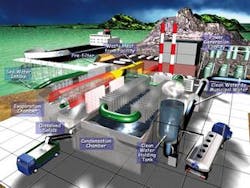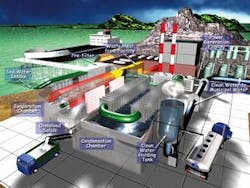Vaporising droplets desalinate water in milliseconds
By Robert Wright
Rapid Spray Evaporation (RSE™) reduces the cost of seawater desalination and brine discharge treatment by 50% to 90%, while doubling freshwater production, according to AquaSonics International, the US company that developed the patented process.
Currently, the company reports that over 100 new seawater desalination plants of all types and each averaging about 25 million gallons of water production per day will be in construction or in the planning stage within the next two years. These new facilities could include RSE plants added on to existing desalination facilities and stand-alone RSE plants.
These conventional facilities will, in turn, each generate an average of twenty million gpd of brine at 7% salinity. Original feed water contains 3.5% salt. Unlike the more common and conventional seawater desalination facilities, RSE technology treats this brine and doubles the freshwater capacity of the facility, and produces thousands of pounds of commercially salable salt, while eliminating the environmental, political and disposal costs of the brine.
AquaSonics developed the working design and patented the process in October 2001. Additional patents are in development and some are pending worldwide.
Last 18 April AquaSonics Inter-national unveiled its first commercially viable working prototype unit before federal and state officials, demonstrating the technology's ability to process up to 3,000 gpd of seawater or brine and convert almost the entire volume into distilled water and recover the removed dissolved salts in dry form. The Atlanta-based company recently produced portable units that can convert up to 11,000 litres of water a day, and is scaling up the equipment for applications in larger desalination facilities.
AquaSonics' Chief Henry Lloyd reported: "A recently conducted test yielded extraordinary results. The feeder solution had 160,000 milligrams per litre (mg/l) of salt, which is the equivalent to 16% or four times greater than seawater at 3.5%, and forty times greater than brackish water at 0.35%. The process reduced salt content to 400 mg/l, which is comparable to most municipal tap water consumed. Able to handle 20% or more salinity, RSE is the only known technology capable of economically processing water solutions with salinity greater than 4.5%."
RSE differs from traditional desalination methods because it focuses on the benefits of high surface area associated with small droplets. Droplet evaporation is achieved in less than 25 milliseconds. In RSE, contaminated water is ejected at high velocities through specialised injector-nozzles, which creates water droplets. The salt water changes from liquid to vapour within milliseconds of ejection. As the solution evaporates, the solids contained in the solution are flashed out or separated, leaving pure water vapour that subsequently condenses and is collected, without the solids previously dissolved and suspended in the solution. The formerly dissolved solids precipitate out as a dry product that can subsequently be mined for valuable minerals and chemicals, or reused, depending on the application.
For potable water applications, RSE technology is most competitive when used in conjunction with an existing SWRO desalination plant and where sufficient waste heat or other inexpensive heat energy sources are available.
Recovery rate
RSE recovers twice the amount of freshwater from seawater than conventional SWRO, which achieves 40% to 50% recovery from feed water. For example, conventional SWRO desalination facilities produce a maximum one gallon of freshwater and one gallon of brine discharge with twice the salinity (i.e. 7%). The RSE process is capable of treating one gallon of brine discharge and converting it into one gallon of freshwater and a dry by-product.
In industrial applications, the near 100% recovery means that these industries can effectively eliminate wastewater discharges and recycle the treated water for reuse as process water.
Composition
Different compositions of total dissolved solids (TDS) in feed water generally require different specialised filter membranes for RO and SWRO. Erratic or varying compositions in the feed water can damage and destroy the operating characteristics of a RO facility and render it useless. RSE is not dependent on the composition or degree of TDS/salinity. For RSE, there is no significant increase in costs for separation regardless of the type of dissolved solids or the amount present in the solution.
Maximum salinity
RSE can handle three times the maximum salinity of SWRO, i.e. 16% for RSE. This means that RSE can easily process the brine discharge derived from conventional SWRO facilities, plus more toxic solutions, such as evaporator pond water, which is typically 12% to 18% TDS. Test results project that RSE should be able to handle up to full saturation - up to 25% salinity.
The RSE process significantly reduces the cost of disposing hazardous liquids given its ability to handle high salinity and varied composition of TDS in solution. For example, a facility produces 1,000 gallons of wastewater per day with a TDS of 15% and an aggregate weight of 8,000 pounds or four tons. A conventional disposal of this solution would require 20 55-gallon drums. Assuming an average landfill disposal cost of US$ 200 per drum for hazardous material, at 20 drums, the disposal cost is US$ 4,000. The equivalent cost using RSE and supplying heat through conventional gas burners would be US$ 60 (combined capital and operational expense) resulting in 1,000 gallons of water that could be reused, and 1,200 pounds of dry waste that could be recycled for recovery of precious metals, etc. or disposed of at a cost of US$ 500 for a total cost of US$ 560 - a savings of US$ 3,440 or approximately 86%
Desalination cost reduction 75%
When used in conjunction with an existing RO and if waste heat is available from a local power plant or other heat sources, the RSE process can effectively double the amount of water derived from the existing operation at a 75% reduction in costs for additional water. This is achieved by processing the brine discharge from RO, taking advantage of the pre-filtration required by RO, along with its discharge pressures of approximately 800 psi, water temperature of 100ºF, and the water infrastructure for delivery and discharge of feed water and freshwater. Under these conditions, the AquaSonics process can cost approximately US$ 0.75 to US$ 1.25 per 1,000, depending on scale and other factors.
Adding RSE to an existing 5-mgd SWRO facility with an assumed cost of US$ 1 per gpd would result in an additional five million gpd at an increased cost of US$ 5 million for a combined 10 million gpd of fresh water, zero brine and a daily cost of US$ 17,500 per day, or US$ 1.75 per 1,000 gallons.
Salt by-product
Conventional desalination processes generate liquid brine, which must be disposed of as a highly potential toxic substance. RSE does not generate brine; instead it creates a dry by-product, which in the case of seawater, is commonly referred to as sea salt, a commercial bulk commodity whose wholesale price is worth four times the value of the water from which it is derived.
For industrial and commercial applications, the dry by-product contains valuable precious minerals that can be extracted and reused by the manufacturer, and which would not need to be sent to the local landfill. If sent, the reduction in volume of 90%+, and substitution of a dry vs. wet solution would greatly reduce the costs of disposal and type of disposal required. A five-million gpd facility generates 700 tons of salt, which at US$ 44 per ton is worth US$ 30,000 per day.
Environmental impact
Conventional SWRO processes generate a brine discharge with twice the salinity of the local sea environment. Specialised manifold discharge pipes can prevent the concentrated brine from damaging local marine life. In the absence of a storm or other mechanical dispersal agent, the salt brine hangs together as a "cloud," effectively poisoning the habitat for the various life cycles of marine life that would normally pass through different levels of the sea in their maturation stages, or acting as barriers to migratory fish, which perceive the concentration as a "wall," which they must then swim around.
Historically, many desalination proponents have debunked such environmental issues; however with more facilities coming on-line, the combined impact on local business and tourist trade when hatcheries and coral reefs are damaged or destroyed, is resulting in greater awareness, and in some cases, outright blockage of lengthy delays in construction or imposition of heavy fines, which happened in the US states of California and Florida. RSE eliminates this issue altogether by extracting salt as a dry by-product.
Author's NoteRobert Wright is the vice president of engineering for Aquasonics International, based in Atlanta, Georgia, USA. For more information, visit the Website: www.Aquasonics.com


